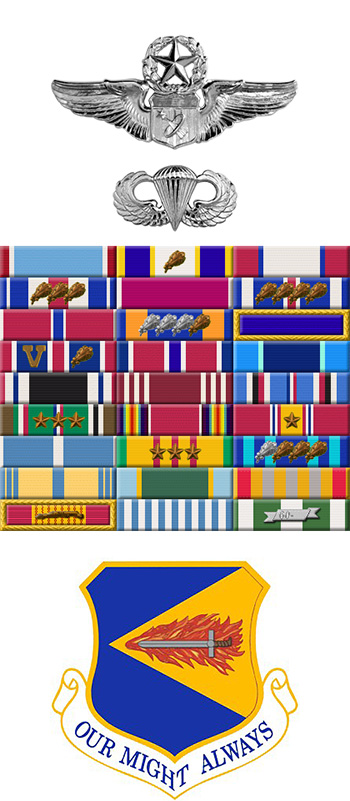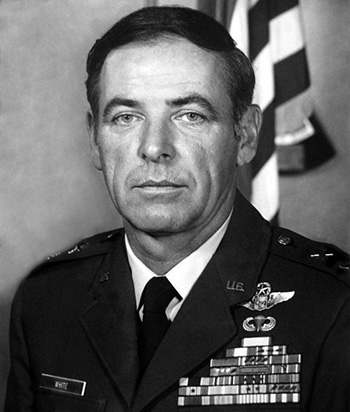
|
Robert M. White |
 |
|||
| Rank, Service | ||||
Major General O-8, U.S. Air Force |
||||
| Veteran of: | ||||
|
||||
| Tribute: | ||||
Bob White was born on July 6, 1924, in New York City, New York. He enlisted in the reserves of the U.S. Army Air Forces on November 25, 1942, and began Aviation Cadet training on May 15, 1943. White was commissioned a 2Lt and awarded his pilot wings on February 8, 1944, and was assigned to the 355th Fighter Group in Europe, where he flew 53 combat missions in the P-51 Mustang from July 1944 until he was shot down and taken as a Prisoner of War on February 23, 1945. He was held at Stalag Luft 3 in Sagan-Silesia, Bavaria, before being moved to Nuremberg-Langwasser. After spending 2 months in captivity, he was released in April 1945, and joined the Air Force Reserve in December 1945. Lt White was recalled to active duty on May 27, 1951, and served with the 514th Troop Carrier Wing at Mitchell AFB, New York, until February 1952, when he was sent to Japan to serve with the 40th Fighter Squadron. He returned to the United States in August 1953, and was assigned to the Rome Air Development Center at Griffiss AFB, New York. Capt White was next assigned to Edwards AFB, California, where he attended Test Pilot School from June 1954 to January 1955, and then served as a Test Pilot until October 1963. During this time, Maj White became the first person to fly Mach 4, Mach 5, and Mach 6, the first to fly above 200,000 and then 300,000 feet, the first person to exceed 3,000 mph, the first person to fly a winged aircraft into space, and he became the 5th American to earn Astronaut Wings. All of these feats were accomplished while flying the X-15 research aircraft. Col White's next assignment was as Operations Officer and then Commander of the 22nd Tactical Fighter Squadron at Bitburg AB, West Germany, from October 1963 to July 1964. He then served as Commander of the 53rd Tactical Fighter Squadron, also at Bitburg, from July 1964 to August 1965, when he received an Industrial College of the Armed Forces assignment to complete his Masters degree at George Washington University. Col White then served as Director of the Tactical Project Office for the F-111 fighter at Wright-Patterson AFB, Ohio, from September 1966 to May 1967. He became the Deputy Commander for Operations of the 355th Tactical Fighter Wing at Takhli Royal Thai AFB, Thailand, in May 1967, and flew 70 combat missions during the Vietnam War. From October 1967 to May 1968, White served on the 7th Air Force staff at Tan Son Nhut AB in the Republic of Vietnam. He then returned to Wright-Patterson AFB, where he served as director of the F-15 Systems Program until August 1970. White then became the commander of the Air Force Flight Test Center at Edwards AFB, where he served from August 1970 to November 1972. Gen White served as commandant of the Air Force ROTC program at Maxwell AFB, Alabama, from November 1972 to March 1975, and then became chief of staff of the Fourth Allied Tactical Air Force at Ramstein AB, West Germany, serving until his retirement from the Air Force on February 1, 1981. Maj Gen White was inducted into the National Aviation Hall of Fame in 2006. Bob White died on March 17, 2010, and was buried at Arlington National Cemetery. |
||||
|
||||

